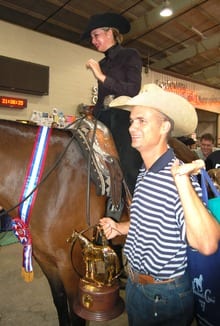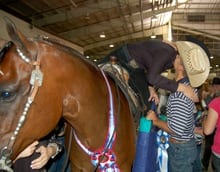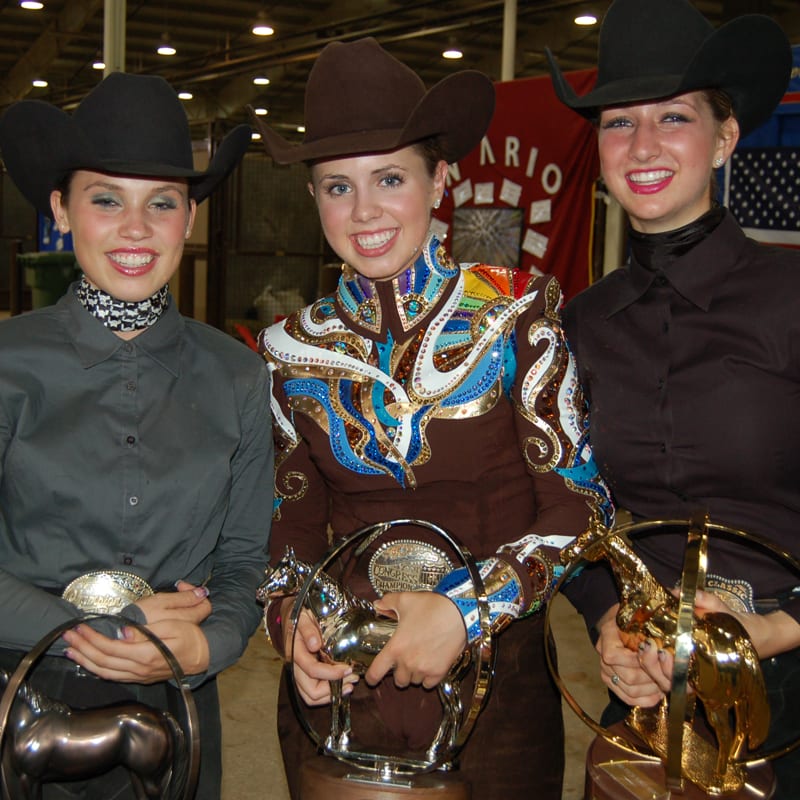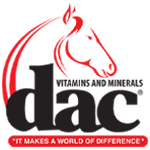At last year’s AQHA Youth World Championship show, Brad Jewett of San Antonio, Texas was on top of the World, literally. Jewett earned recognition for coaching some of the top horsemanship exhibitors in the nation including last year’s AQHA Youth World and Congress 14-18 Horsemanship Champion, Carey Nowacek.
Coming back this year is Lindsey McMullen and Huntin For Money who won the bronze trophy at last year’s AQHA Youth World Show. GoHorseShow discussed in-depth what Jewett likes to see as a coach, trainer, and judge in this difficult and challenging class. He also discusses particular maneuvers and what sets apart some of the top exhibitors from the pack.
While most exhibitors are not gifted with long arms and legs like his client, 2010 AQHA Youth World Champion, Carey Nowacek, he says that the goal should be to use whatever assets you have to your benefit and to really show off your strongest maneuvers. “The tall, long legged girls are not the only ones who win in this class,” Jewett explains. “It is the most effective rider that wisely tones down maneuvers that are not their strongest and then increases the level of difficulty when they are confident they can impress the judges in that aspect of the pattern.”
 Jewett likes the horsemanship class because he feels the best riders can still win on average horses. “A rider doesn’t have to have a six figure horse to win in this class. The rider should never be out-shined by the horse. The horse’s movement is not as important. They should be able to maintain their position when they increase speed and increase the difficulty in the maneuvers.”
Jewett likes the horsemanship class because he feels the best riders can still win on average horses. “A rider doesn’t have to have a six figure horse to win in this class. The rider should never be out-shined by the horse. The horse’s movement is not as important. They should be able to maintain their position when they increase speed and increase the difficulty in the maneuvers.”
Many riders today feel as though increased speed is a way to differentiate themselves. Jewett says that a gutsy ride with increased speed should be rewarded but only if it doesn’t compromise the rider’s body position and result in the rider being left behind or out of cadence with their horse.
The three most important factors Jewett says that sets riders apart is their confidence, body position, and the performance of the maneuvers. He says that issues like attire and rein length are secondary to these components.
Finer Points of Horsemanship
Confidence–Jewett says that is the first impression on the judge is of the utmost importance. The exhibitor must exhibit poise not just during their pattern but also before they start. During their pattern is crucial in leaving a lasting impression with the judge. “I think confidence stands out the most. The judges need to know that the rider has confidence in their trainer, their horse, and in themselves and that they are prepared to perform the pattern well. The judge will see and feel when a competitor believes they are the best. It causes the judge to immediately want to increase their score.”
Body Position–Jewett stressed body position throughout the interview. The rider needs to have correct leg position with correct stirrup length—not too long or too short. The rider needs to be riding through their heel and not on their toes. “I know if someone riding a cutter and a reiner tries to ride on their toes that they would probably fall off. It is important that the rider have adequate weight in their heels and sit in a centered balanced position over their horse,” Brad says. Jewett also says that the free arm needs to be in a natural relaxed position–even with the rein hand where if you are looking at the rider from a far it looks like one arm. Jewett says that some riders have shorter arms which leads them to have their shoulders a little more forward but they need to have a natural feel and look relaxed on their horse not stiff or artificial.
 Performance of Maneuvers–According to Jewett, he says it is important to realize that you can’t do everything perfect and that you need to ride your weak maneuvers correctly where the judge will not penalize you on that maneuver but then on your strongest maneuvers–you better pull out all the stops where you can get credit and ++ plussed on that maneuver. It is important that the rider flows from one maneuver to another. The rider needs to focus on the positive and bring out their strong points. He says that speed doesn’t overrule correctness. Brad mentioned that Carey didn’t have the best transition out of her turn in her World Show pattern last year in her third maneuver, but that she recovered quickly–got right back on track and that the rest of her pattern was strong. If your horse doesn’t spin very well–then just try to get through it without hesitating or getting hung up in the spin. Brad stresses focusing on your positives and not spend too much time worrying about your weaknesses where it deflates your confidence.
Performance of Maneuvers–According to Jewett, he says it is important to realize that you can’t do everything perfect and that you need to ride your weak maneuvers correctly where the judge will not penalize you on that maneuver but then on your strongest maneuvers–you better pull out all the stops where you can get credit and ++ plussed on that maneuver. It is important that the rider flows from one maneuver to another. The rider needs to focus on the positive and bring out their strong points. He says that speed doesn’t overrule correctness. Brad mentioned that Carey didn’t have the best transition out of her turn in her World Show pattern last year in her third maneuver, but that she recovered quickly–got right back on track and that the rest of her pattern was strong. If your horse doesn’t spin very well–then just try to get through it without hesitating or getting hung up in the spin. Brad stresses focusing on your positives and not spend too much time worrying about your weaknesses where it deflates your confidence.
Secondary Factors
Length of Rein–Jewett says that he has let riders with shorter and longer reins win–he says that it is secondary to the three factors he mentioned above. However, it does say that the rider needs to have a soft feel and does not like to see a huge drape in the reins or for the rider to have a choke hold on the horse either–especially if it inhibits their movement. The rider has to have the confidence to pull off whatever length they decide to use.
Lead Change–He says that a flying lead change is important to have to win at the big shows but that your horse doesn’t have to have a Harley D Zip lead change to be competitive. The horse and rider just need to maintain their cadence and forward motion and execute a smooth lead change. Regardless if you perform a flying or simple lead change it needs to be smooth and fluid.
Rollbacks and Turns—If your horse’s strongest maneuver is the turn, you need to make sure you pull it off effortlessly. It needs to be smooth, fluid, and no hesitations. However, you also need to make sure not to over spin or ask you horse for more than he is able to give you. Again, like mentioned earlier, if the turns are your weakest, just try to perform it where you don’t lose points.
 Extended trots and hand gallops–Kudos goes to the riders that can pull off showing an extreme difference in speed but the higher degree of difficulty also has greater risk. There needs to be an obvious difference in speed but make sure whatever increase in speed that the rider chooses does not result in them losing their body position.
Extended trots and hand gallops–Kudos goes to the riders that can pull off showing an extreme difference in speed but the higher degree of difficulty also has greater risk. There needs to be an obvious difference in speed but make sure whatever increase in speed that the rider chooses does not result in them losing their body position.
Railwork–Jewett says that the rail work is mainly used as a tie breaker. He says that it can’t move you up too far but it can sure move you down. Brad does say that he believes that the rail work is largely overlooked and needs to be taken a little bit more seriously at the shows. He also mentions that if the rider drops their stirrups on the rail and they are six inches lower than where the rider’s heel is–then that is a sign that the rider is not riding in a balanced position with weight in their heel–they are probably riding on their toes. Brad also mentions, “If a horse is acting up on the rail but the horse behaved during the pattern, and the rider is able to maintain their poise and keep the horses between the reins, then I may not hurt the rider as long as she/he is able to keep the horse under control.”
Headsets–He doesn’t like to see a horse intimidated or overbridled or excessively nosed out. He also doesn’t care for a horse that excessively gaps his mouth and that is fractious and resistant to the rider’s cues. It has to be aesthetically pleasing with the rider having a soft feel and subtle communication cues.
Attire–There has been a lot written about his client Carey Nowacek starting the trend of the plain button down shirt in the horsemanship. Jewett says that it wasn’t his idea for her to wear a plain shirt and that it is fine for certain body types, but that many people can’t pull it off. He says that some jewels and bling is fine–the outfit just needs to be clean, fit well, and show off your profile in a way that flatters and shows off your correct body position.
Learn from Mistakes–Brad says that the rider needs to learn from their mistakes in order to improve. He says it is all about preparing the rider and setting goals and challenges at each show. There needs to be a game plan. “We are always prepping and preparing for the World and the Congress. If you show five times and only do well once–then you need to learn from the one time you did well and draw the positive out of that experience and try to move forward to try and do it again,” Brad says.
 Pattern design–Brad would also like to challenge fellow judges to design their own patterns and really think about the patterns so they know what they are looking for. If they didn’t design the patterns, then, they need to at least look over the patterns so they know how the pattern flows so they can have a clear picture of what an ideal pattern would look like in their eyes.
Pattern design–Brad would also like to challenge fellow judges to design their own patterns and really think about the patterns so they know what they are looking for. If they didn’t design the patterns, then, they need to at least look over the patterns so they know how the pattern flows so they can have a clear picture of what an ideal pattern would look like in their eyes.
Quality of Movement–Jewett says that the rider needs to be riding like they are going somewhere. A pleasure lope and jog are not appropriate in this class. “I like what I call a purposeful jog–it would be a medium speed jog, more intense. It is a lot easier to move up to an extended jog and hand gallop from this speed than someone who chooses to ride excessively slow.”
Concluding Thoughts
Jewett says that many of his new clients don’t understand the hard work of riding without stirrups, doing drills and the intense preparation that goes into being successful in the show ring. “You definitely can’t just be lucky to win the world in the horsemanship–there are several hours of holding the correct position during practices, riding without stirrups, and learning to communicate with their horse. This hard work and preparation usually shows itself off in the show ring.”









